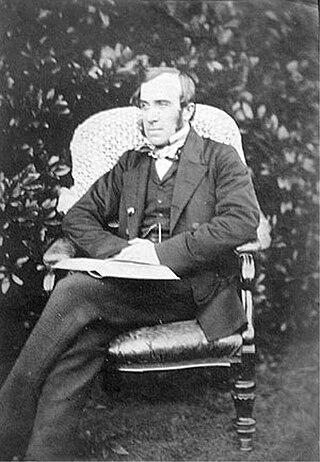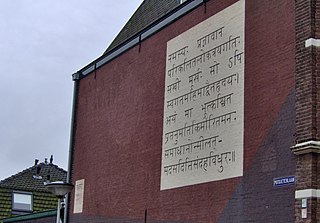
The Mahābhārata is one of the two major Smriti texts and Sanskrit epics of ancient India revered in Hinduism, the other being the Rāmāyaṇa. It narrates the events and aftermath of the Kurukshetra War, a war of succession between two groups of princely cousins, the Kauravas and the Pāṇḍavas.

Apsaras are a member of a class of celestial beings in Hindu and Buddhist culture They were originally a type of female spirit of the clouds and waters, but, later play the role of a "nymph" or "fairy". They figure prominently in the sculptures, dance, literature and paintings of many South Asian and Southeast Asian cultures.

Vishvamitra is one of the most venerated rishis or sages of ancient India. Vishvamitra is one of the seven Brahmarshi. According to Hindu tradition, he is stated to have written most of the Mandala 3 of the Rigveda, including the Gayatri Mantra (3.62.10). The Puranas mention that only 24 rishis since antiquity have understood the whole meaning of —and thus wielded the whole power of — the Gayatri Mantra. Vishvamitra is supposed to have been the first, and Yajnavalkya the last.

Kālidāsa was a Classical Sanskrit author who is often considered ancient India's greatest poet and playwright. His plays and poetry are primarily based on Hindu Puranas and philosophy. His surviving works consist of three plays, two epic poems and two shorter poems.

Sir Monier Monier-Williams was a British scholar who was the second Boden Professor of Sanskrit at Oxford University, England. He studied, documented and taught Asian languages, especially Sanskrit, Persian and Hindustani.

In Hindu scriptures, Durvasa, also known as Durvasas, is a legendary rishi (sage). He is the son of Anasuya and Atri. According to some Puranas, Durvasa is a partial avatar of Shiva, known for his short temper. Wherever he goes, he is received with great reverence by humans and devas alike.

Shakuntala is the wife of Dushyanta and the mother of Emperor Bharata. Her story is told in the Adi Parva, the first of eighteen parts of the ancient Indian epic Mahabharata, and dramatized by many writers, the most famous adaptation being Kalidasa's play Abhijñānaśākuntala.

The term Indian classical drama refers to the tradition of dramatic literature and performance in ancient India. The roots of drama in the Indian subcontinent can be traced back to the Rigveda, which contains a number of hymns in the form of dialogues, or even scenes, as well as hymns that make use of other literary forms such as animal fables However, Indian drama begins its classical stage in the classical period with the composition of the Nātyaśāstra. Indian classical drama is regarded as the highest achievement of Sanskrit literature.

Menaka is a apsara in Hindu literature.

Dushyanta is a king of the Chandravamsha (Lunar) dynasty featured in Hindu literature. He is the husband of Shakuntala and the father of Bharata. He appears in the Mahabharata and in Kalidasa's play, Abhijnanashakuntalam.

Sanskrit has been studied by Western scholars since the late 18th century. In the 19th century, Sanskrit studies played a crucial role in the development of the field of comparative linguistics of the Indo-European languages. During the British Raj (1857–1947), Western scholars edited many Sanskrit texts which had survived in manuscript form. The study of Sanskrit grammar and philology remains important both in the field of Indology and of Indo-European studies.

Bharata is a legendary emperor featured in Hindu literature. He is a member of the Chandravamsha dynasty, and becomes the Chakravarti. He is regarded to be the ancestor of the Pandavas, the Kauravas, Brihadhrata, and Jarasandha. The Bhāratas, a prominent historical tribe mentioned in the Rigveda, are regarded in Hinduism to be the descendants of Bharata.
Kāvya refers to the Sanskrit literary style used by Indian court poets flourishing between c.200 BCE and 1200 CE.

Vikramōrvaśīyam is a five-act Sanskrit play by ancient Indian poet Kālidāsa, who lived in the 4th or 5th Century CE, on the Vedic love story of King Pururavas and an Apsarā named Ūrvaśī, known for her beauty.

Shakuntala is an Indian television series that premiered on 2 February 2009 and aired until 6 July 2009. The show was based on characters in Hinduism where Shakuntala is the wife of Dushyanta and the mother of Emperor Bharata. Her story is told in the Mahabharata and dramatized by Kalidasa in his play Abhijñānaśākuntala(The Sign of Shakuntala).

The Siddhivinayaka Mahaganapati Temple is a Hindu temple located in Titwala, a small town in the Kalyan taluka of Thane district – near Mumbai, Maharashtra, India. The temple is dedicated to the Hindu, elephant-headed god of wisdom Ganesha. Titwala is believed to be the putative site of the hermitage of sage Kanva, foster parent of Shakuntala who was born here. The place is steeped in ancient legend and the temple is frequented by a very large number of devotees on account of the belief that separated married couples could be united and marriages of desired people could be fixed easily if the Ganesha image installed in the temple is worshipped with devotion.This temple is frequented mostly on Tuesdays.

Shakuntala is a 1943 drama film based on Kālidāsa's Sanskrit drama Abhijñānaśākuntalam, directed by V. Shantaram. It was the first film made under the newly formed Rajkamal Kalamandir banner that Shantaram had started. It was the first film to be shown commercially in US. Adapted from the Shakuntala of Kalidas the screenplay was by Diwan Sharar. Music was composed by Vasant Desai with lyrics by Diwan Sharar and Ratan Piya. The cinematatography was by V. Avadhoot and the film starred Kumar Ganesh, Jayashree, Chandra Mohan, Ameena, Shantaram, Zohra and Nana Palsikar.
Shakuntala is character from the Hindu epic Mahabharata.

Sakunthala is a 1966 Telugu-language Hindu mythological film directed by Kamalakara Kameswara Rao. The film stars N. T. Rama Rao and B. Saroja Devi, with music composed by Ghantasala. It is produced by Lakshmi Rajyam and Sridhar Rao under the Rajyam Productions banner.



















